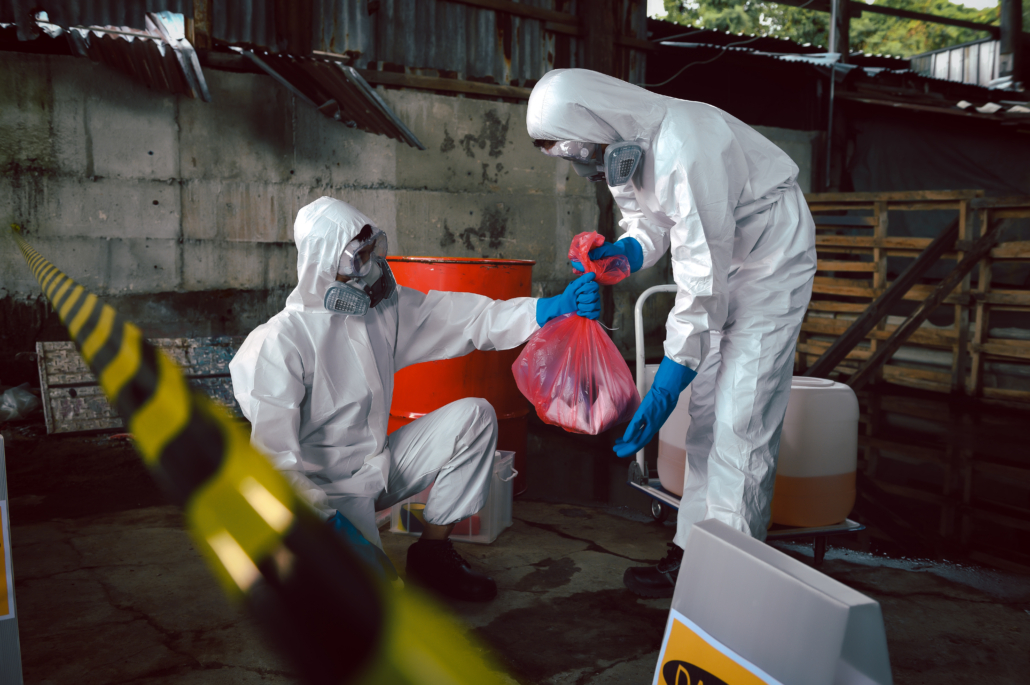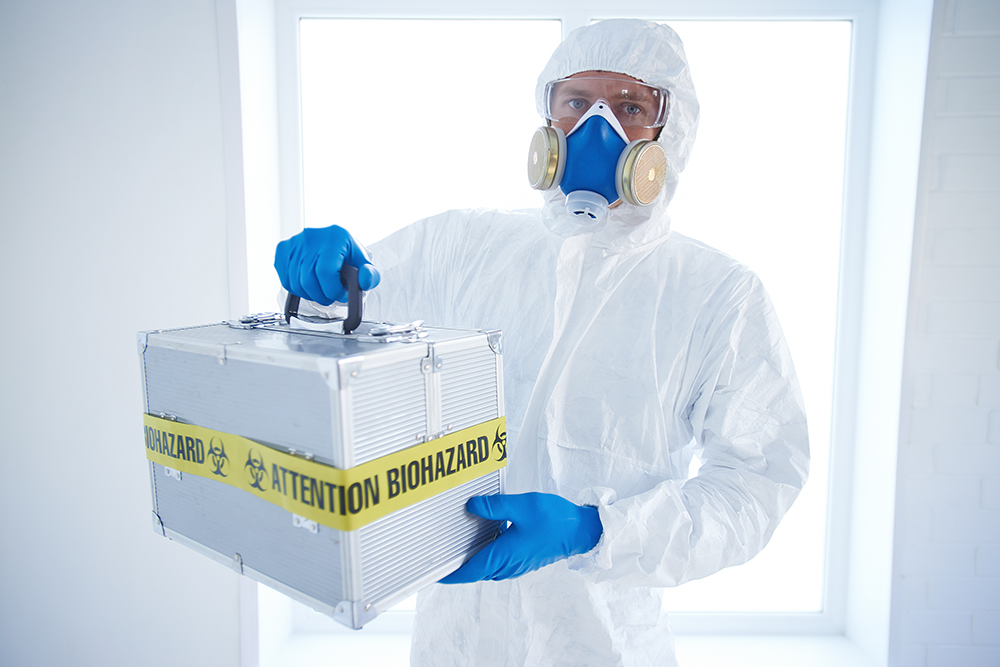Biohazard Removal: Safe Handling and Disposal of Hazardous Materials
Biohazard Removal: Safe Handling and Disposal of Hazardous Materials
Blog Article
Specialist Biohazard Cleaning and Purification for Blood, Bodily Fluids, and Hazardous Products
The prospective health risks connected with direct exposure to biohazards emphasize the crucial demand for precise handling and extensive cleanup. As we navigate the elaborate landscape of biohazard cleaning, recognizing the nuances of regulations, conformity, and the specialized devices at play becomes critical in guaranteeing a detailed and safe decontamination procedure.
Health And Wellness Dangers of Biohazard Direct Exposure
Exposure to biohazards poses significant wellness threats that can result in serious consequences for individuals and areas alike. Biohazards incorporate a variety of organic materials, consisting of blood, physical fluids, mold, germs, viruses, and other potentially transmittable products. When people come right into contact with these biohazards, whether with accidents, incorrect handling, or environmental exposure, they encounter the danger of having severe illnesses or conditions.
Among the primary health and wellness threats connected with biohazard direct exposure is the transmission of contagious diseases. Bloodborne microorganisms such as HIV, hepatitis B and C, and various germs can be existing in biohazardous materials, presenting a straight risk to human wellness. Inhaling airborne biohazards like mold and mildew spores or entering into contact with infected surfaces can likewise lead to respiratory system problems, allergies, and other damaging health and wellness impacts.
Moreover, biohazard direct exposure can have long-term health ramifications, with some conditions manifesting years after the preliminary contact (Blood Cleanup). As a result, it is essential to prioritize proper biohazard cleaning and purification to alleviate these health threats and ensure the safety and security of individuals and areas

Specialized Training for Biohazard Cleaning
When it pertains to handling biohazard clean-up efficiently and securely, specialized training plays a fundamental duty in making sure appropriate decontamination procedures are adhered to. Biohazard clean-up requires certain expertise and abilities to efficiently alleviate threats connected with bloodborne pathogens, physical fluids, and harmful materials. Specialists learnt biohazard clean-up go through extensive direction on how to safely handle, get rid of, and deal with biohazardous products to protect against contamination and exposure.
Specialized training for biohazard cleaning covers a variety of vital subjects, consisting of correct individual safety equipment (PPE) usage, bloodborne virus recognition, purification strategies, and harmful waste disposal methods. Individuals learnt biohazard cleaning are outfitted with the essential competence to examine contamination degrees, recognize possible threats, and implement ideal clean-up procedures in conformity with governing requirements.
Continuous training and education are paramount in the area of biohazard cleaning to remain updated on the newest decontamination modern technologies, safety methods, and policies. By spending in specialized training, biohazard clean-up experts can effectively react to emergency situation cleaning situations and guard both public health and wellness and the setting.
Significance of Proper Decontamination Techniques
Utilizing appropriate purification methods is crucial in biohazard cleanup to successfully eliminate dangerous materials and reduce health and wellness threats. Effective purification not only ensures the removal of visible traces of blood, physical liquids, and various other biohazards however additionally targets undetectable microorganisms that may posture serious health and wellness risks if not appropriately eradicated. By adhering to stringent purification protocols, educated professionals can dramatically reduce the threat of direct exposure to unsafe microorganisms, viruses, and bacteria that can lead to illness or infections.
Appropriate decontamination techniques include making use of specialized equipment and anti-bacterials that are particularly developed to neutralize biohazards efficiently. Complete cleansing and sanitation of contaminated locations are important to avoid the spread of virus and ensure a safe atmosphere for occupants. In addition, the correct disposal of biohazardous waste following decontamination procedures is crucial in preventing contamination of various other surfaces or individuals.

Tools and Tools for Safe Cleanup
The correct tools and devices play a critical function in ensuring the secure and reliable clean-up of biohazardous products. When taking care of blood, physical liquids, or unsafe materials, biohazard cleaning professionals depend on specialized gear to lessen direct exposure dangers and completely decontaminate the afflicted location. Individual protective tools (PPE) such as gloves, coveralls, safety glasses, and masks are vital to shield versus straight contact with possibly transmittable products. Additionally, biohazard cleaning kits consisting of anti-bacterials, absorptive materials, and biohazard bags are made use of to securely have and dispose of polluted things. Blood Cleanup.
Advanced cleaning tools like hospital-grade anti-bacterials, HEPA-filtered vacuum cleaners, and fogging machines are employed to sanitize surface areas and remove biohazards properly. Specialized tools such as sharps containers and biohazard garbage disposal containers are used to securely manage sharp objects and biohazardous waste materials. By using the ideal devices and devices, biohazard cleansing experts can guarantee an extensive cleanup procedure that focuses on safety and security and minimizes health and wellness dangers for both workers and passengers of the affected area.
Laws and Compliance in Biohazard Cleaning
Correct adherence to policies and conformity requirements is extremely important in biohazard cleansing to ensure the safety of both personnel and the atmosphere. Government firms such as OSHA (Occupational Safety And Security and Wellness Management) and the EPA (Environmental Security Agency) have developed particular standards for biohazard clean-up treatments to minimize health and wellness dangers and environmental contamination. These guidelines cover a variety of facets consisting of the handling, transportation, and disposal of biohazardous materials, as well as the essential training and safety equipment needed for employees associated with the cleaning procedure.
Biohazard cleaning companies need to remain current with these guidelines to guarantee that their operations satisfy the required safety and security standards. Failure to adhere to these policies can result in extreme effects, including penalties, lawful action, and threatening the health and wellness of individuals and the setting. By complying with rigid regulations and conformity measures, biohazard cleansing companies can successfully alleviate threats and make sure a risk-free and extensive cleanup process for all parties involved.
Verdict
To conclude, biohazard cleaning and decontamination call for customized training, proper methods, and adherence to laws. Direct exposure to blood, bodily liquids, and hazardous materials presents significant health and wellness threats, making it crucial to make use of the right equipment and flood damage restoration devices for secure cleaning. By adhering to stringent procedures and standards, experts can effectively reduce the threats related to biohazard direct exposure and ensure the security of both themselves and others.
As we navigate the complex landscape of biohazard cleaning, comprehending the nuances of regulations, conformity, and the specific tools at play ends up being critical in guaranteeing a safe and complete purification procedure. (Blood Cleanup)
When it comes to managing biohazard clean-up successfully and securely, specialized training plays an essential function in making certain correct decontamination treatments are complied with.Making use of proper decontamination methods is essential in biohazard cleaning to properly reduce and remove harmful products health dangers. Additionally, biohazard cleansing kits including disinfectants, absorptive materials, and biohazard bags are utilized to safely contain and get rid of of infected items.
Government firms such as OSHA (Occupational Safety And Security and Wellness Management) and the EPA (Environmental Security Company) have established certain guidelines for biohazard clean-up treatments to reduce health risks and ecological contamination.
Report this page